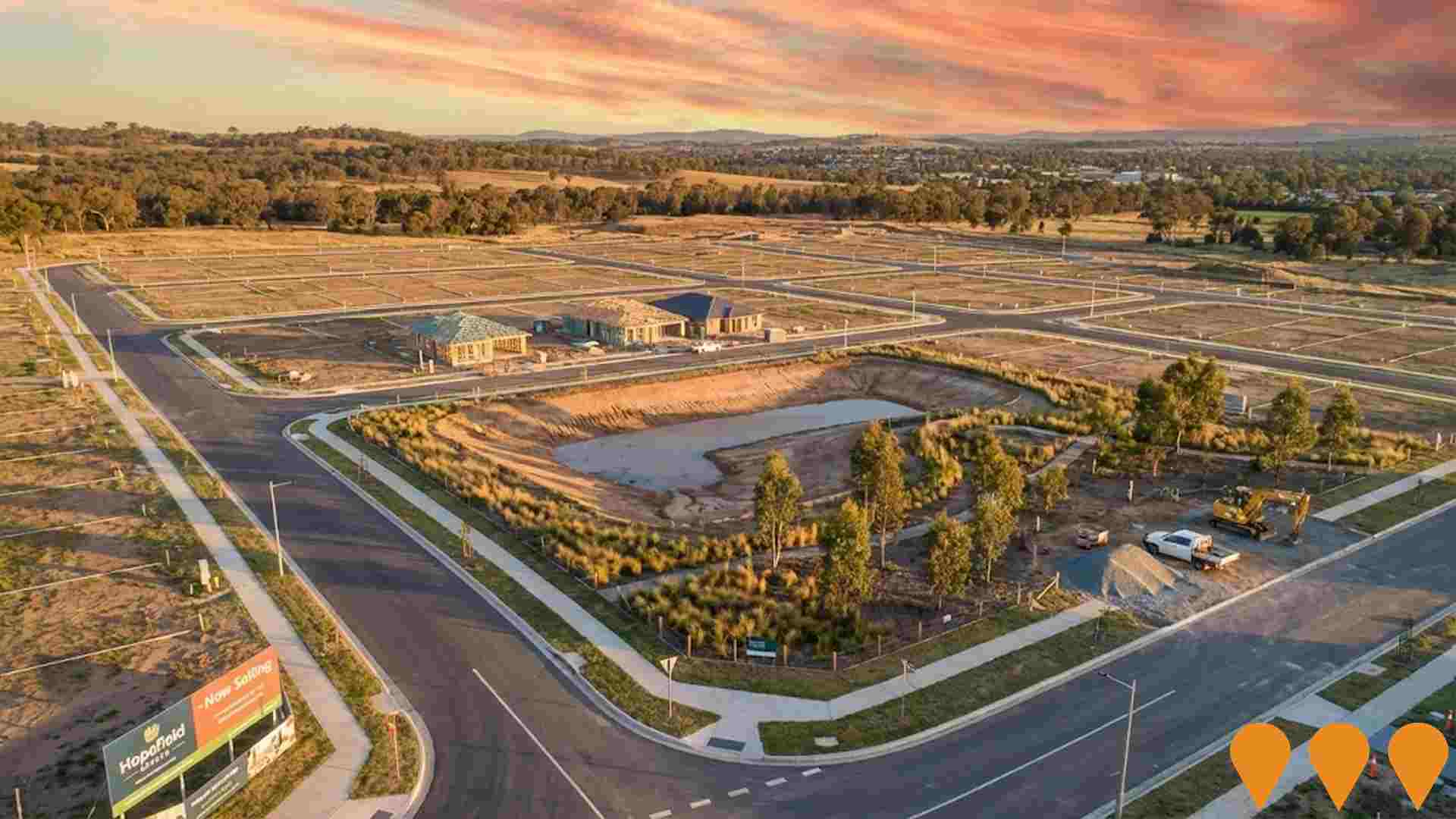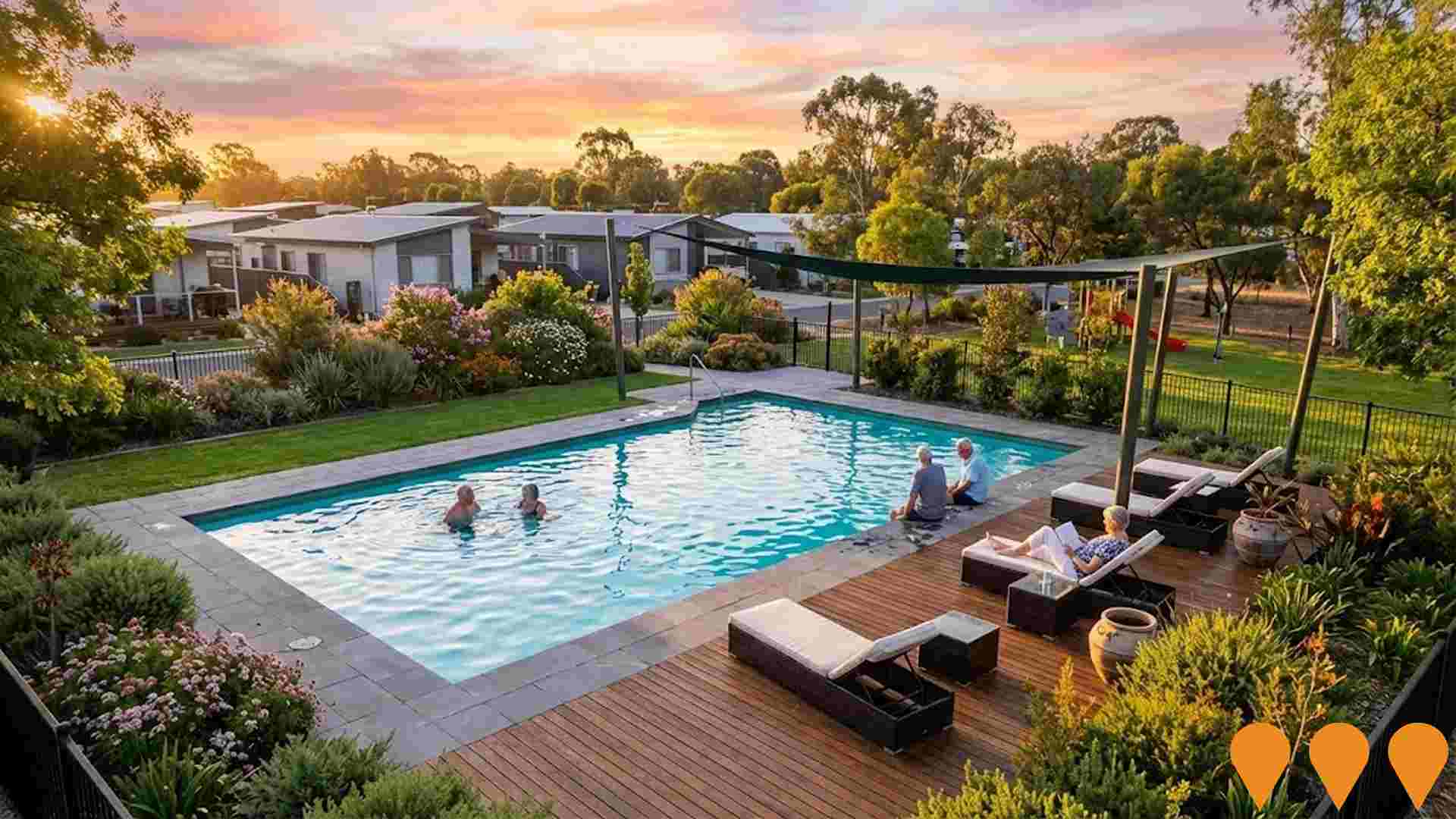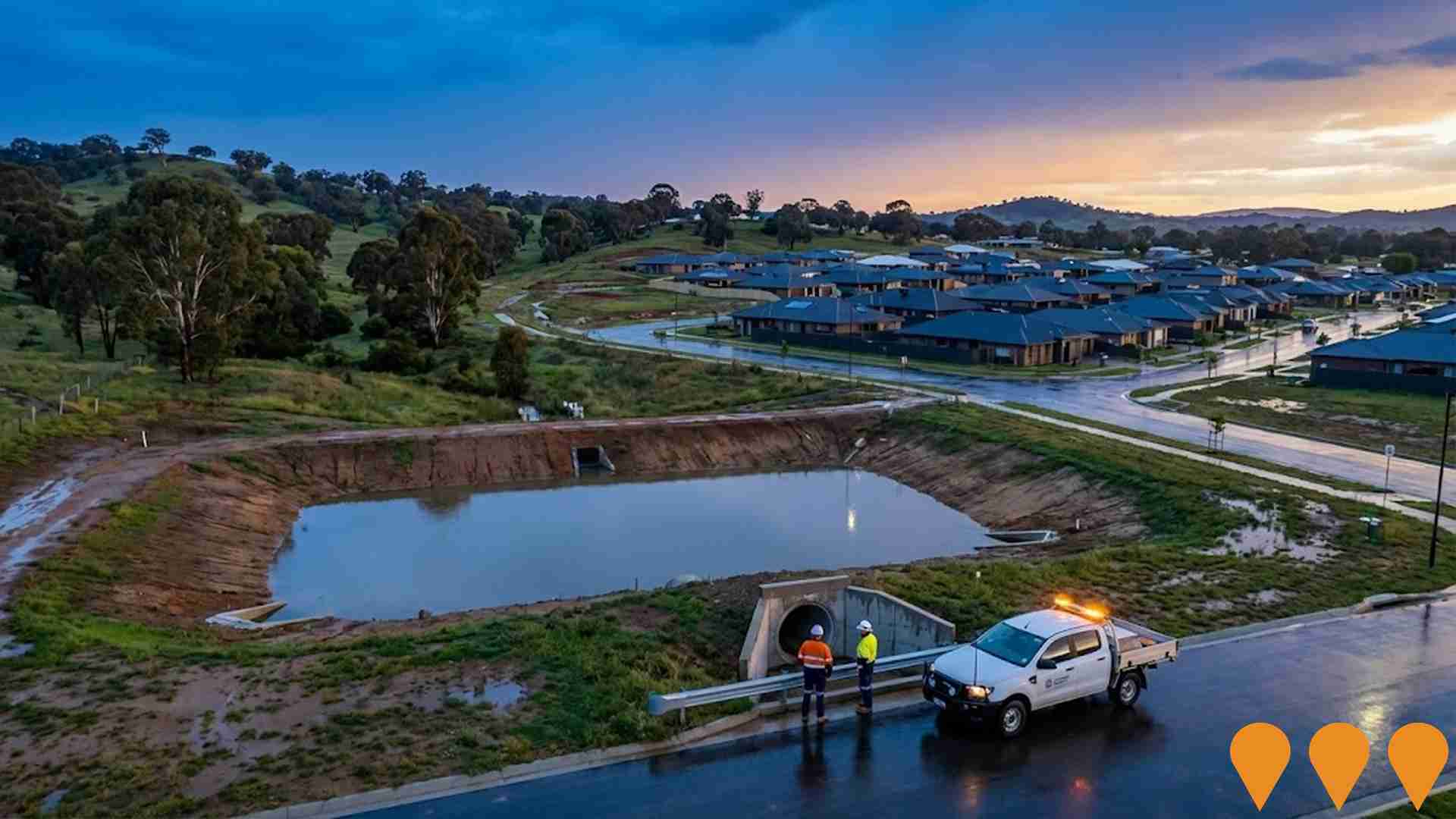Chart Color Schemes
est. as @ -- *
ABS ERP | -- people | --
2021 Census | -- people
Sales Activity
Curious about local property values? Filter the chart to assess the volume and appreciation (including resales) trends and regional comparisons, or scroll to the map below view this information at an individual property level.
Find a Recent Sale
Sales Detail
Population
Population growth drivers in Lavington are strong compared to national averages based on AreaSearch's ranking of recent, and medium to long-term trends
Lavington's population, as of November 2025, is approximately 15,861 people. This represents an increase from the 2021 Census figure of 15,665 people, marking a rise of 196 individuals (1.3%). The change can be inferred from the estimated resident population of 15,664 in June 2024 and the addition of 195 validated new addresses since the Census date. This results in a population density ratio of 738 persons per square kilometer, which is roughly consistent with averages observed across other locations assessed by AreaSearch. Overseas migration contributed approximately 63.0% to overall population gains during recent periods, driving primary growth in the area.
AreaSearch employs ABS/Geoscience Australia projections for each SA2 area, released in 2024 with a base year of 2022. For areas not covered by this data, AreaSearch uses NSW State Government's SA2 level projections, released in 2022 with a base year of 2021. Growth rates by age group from these aggregations are applied to all areas for the years 2032 to 2041. Considering projected demographic shifts, regional areas nationally are expected to experience above median population growth. Lavington is projected to grow by 2,425 persons by 2041 based on latest population numbers, indicating a total gain of 13.7% over the 17-year period.
Frequently Asked Questions - Population
Development
Residential development activity is lower than average in Lavington according to AreaSearch's national comparison of local real estate markets
Lavington has recorded approximately 48 residential properties granted approval annually over the past five financial years, totalling 240 homes. As of FY-26, 31 approvals have been recorded. Based on an average of 1.1 new residents per year per dwelling constructed between FY-21 and FY-25, supply and demand appear balanced, with recent figures indicating a shift to -0.1 people per dwelling over the past two financial years. Development projects average $280,000 in construction value. Additionally, $11.1 million in commercial development approvals have been recorded this financial year.
Compared to Rest of NSW, Lavington records lower building activity, 58.0% below regional average per person. Recent construction comprises 74.0% detached houses and 26.0% attached dwellings. The estimated count of 457 people in the area per dwelling approval reflects its quiet development environment. Population forecasts indicate Lavington will gain 2,174 residents by 2041. If current construction levels persist, housing supply may lag population growth, potentially intensifying buyer competition and underpinning price growth.
Population forecasts indicate Lavington will gain 2,174 residents through to 2041. Should current construction levels persist, housing supply could lag population growth, likely intensifying buyer competition and underpinning price growth.
Frequently Asked Questions - Development
Infrastructure
Lavington has emerging levels of nearby infrastructure activity, ranking in the 34thth percentile nationally
Changes to local infrastructure significantly impact an area's performance. AreaSearch identified 26 projects that could affect this region. Notable initiatives include the Lavington Swim Centre Redevelopment, River Gum project, Lavington Social Housing Project, and Kerr Road Infrastructure Upgrades. The following list details those expected to have the most relevance.
Professional plan users can use the search below to filter and access additional projects.
INFRASTRUCTURE SEARCH
 Denotes AI-based impression for illustrative purposes only, not to be taken as definitive under any circumstances. Please follow links and conduct other investigations from the project's source for actual imagery. Developers and project owners wishing us to use original imagery please Contact Us and we will do so.
Denotes AI-based impression for illustrative purposes only, not to be taken as definitive under any circumstances. Please follow links and conduct other investigations from the project's source for actual imagery. Developers and project owners wishing us to use original imagery please Contact Us and we will do so.
Frequently Asked Questions - Infrastructure
Glenroy Aboriginal Affordable Housing Project
Development of approximately 200 affordable housing units and industrial facilities on an 81,000 sqm block for the Aboriginal community, supported by a $590,000 grant. The project remains stalled due to native title issues and has not progressed past the proposed stage. There is no publicly available update suggesting the native title issues have been resolved as of October 2025. The developer continues to operate various community services.
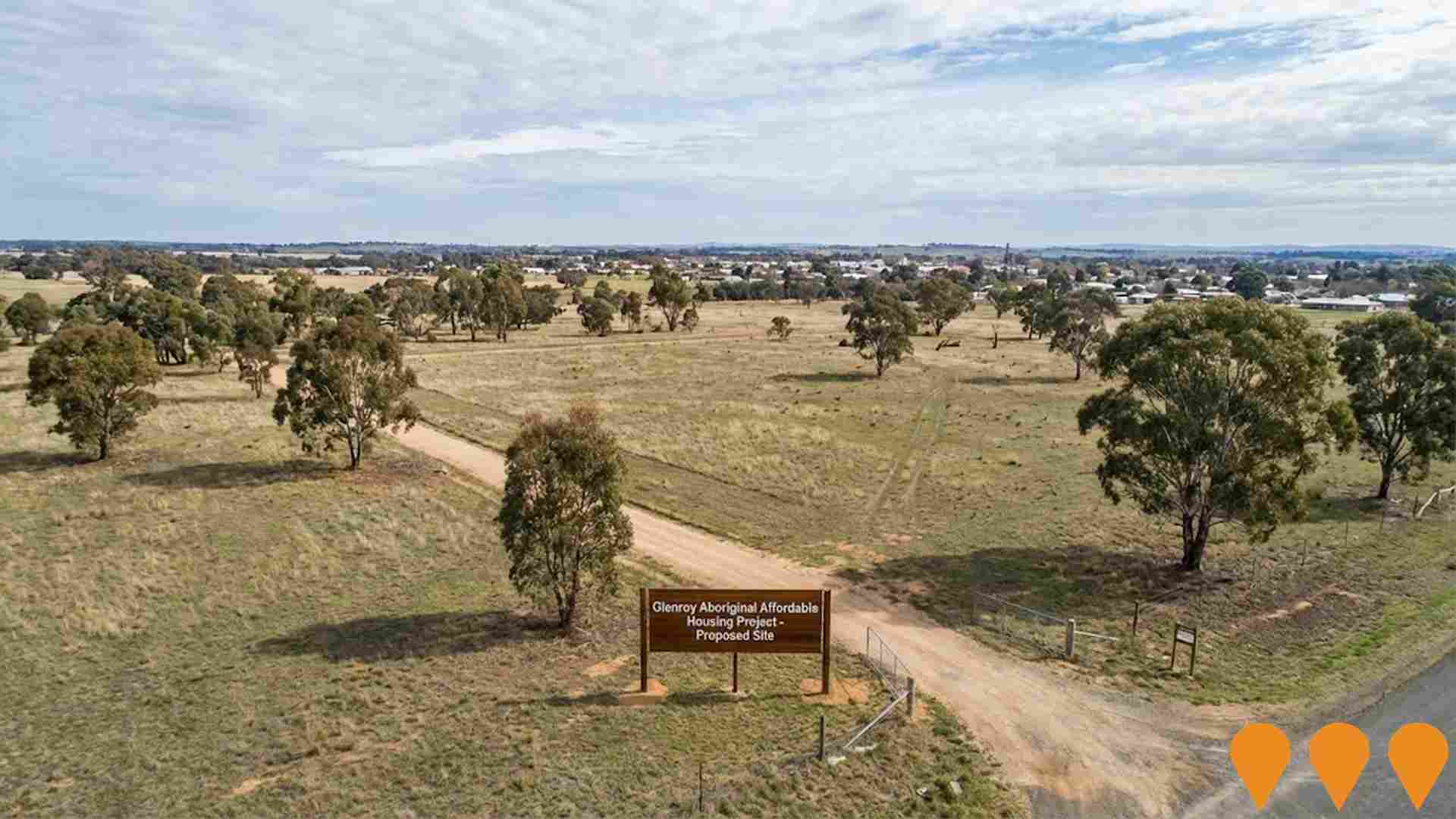
Albury Wodonga Regional Hospital Redevelopment
AUD 558 million joint NSW-Victorian-Commonwealth funded redevelopment of Albury Wodonga Health (Albury Campus). Delivering a new 7-storey Clinical Services Tower and separate Northeast Building. Key features include 80+ additional beds, expanded emergency department, new operating theatres (including hybrid theatre), expanded ICU, new 32-bed adult mental health unit, upgraded maternity and special care nursery, dedicated paediatric unit, and consolidated cancer services. Construction commenced early 2025 by Hansen Yuncken; Northeast Building due for completion 2026, main Clinical Services Tower 2028.
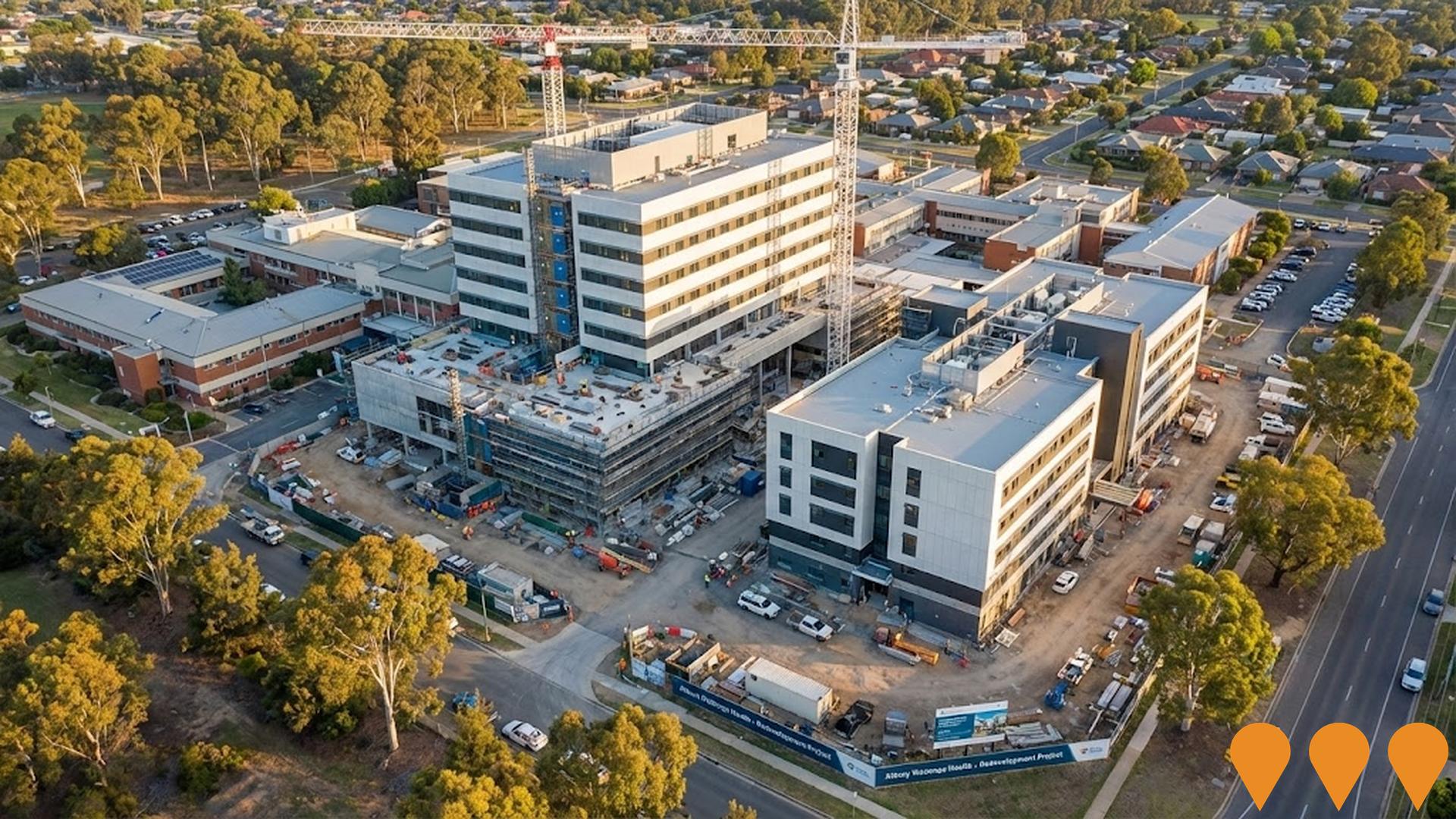
Lavington Swim Centre Redevelopment
The $45.1 million redevelopment (Stage 3) of the Lavington Swim Centre includes a 10-lane 50-metre competition pool, a dedicated 35-metre x 25-metre water polo pool with uniform 2-metre depth, a 25-metre x 15-metre utility pool for lap swimming and remedial use, a splash pad for interactive water play, a new pool building with administration, kiosk, change rooms, amenities, and a Changing Places facility, a flexible multi-purpose social room, and shaded arbour structures with seating, BBQ, and picnic areas. The project replaces the 1967 facility at the end of its service life, aiming to provide modern, inclusive, and accessible aquatic facilities. Stage 3 was endorsed by Council in May 2025 following community consultation, with detailed design underway with Canvas Projects and construction planned to commence in 2027.

Lavington Square Shopping Centre Upgrades
The Reimagining Lavington project involves upgrading the Lavington Square Shopping Centre with a new food court, refreshed fresh food precinct, new play area, upgraded lighting, modern aesthetics, interactive play zones, refreshed car parks, improved wayfinding, and remodelled amenities to enhance the customer experience and serve the growing community.
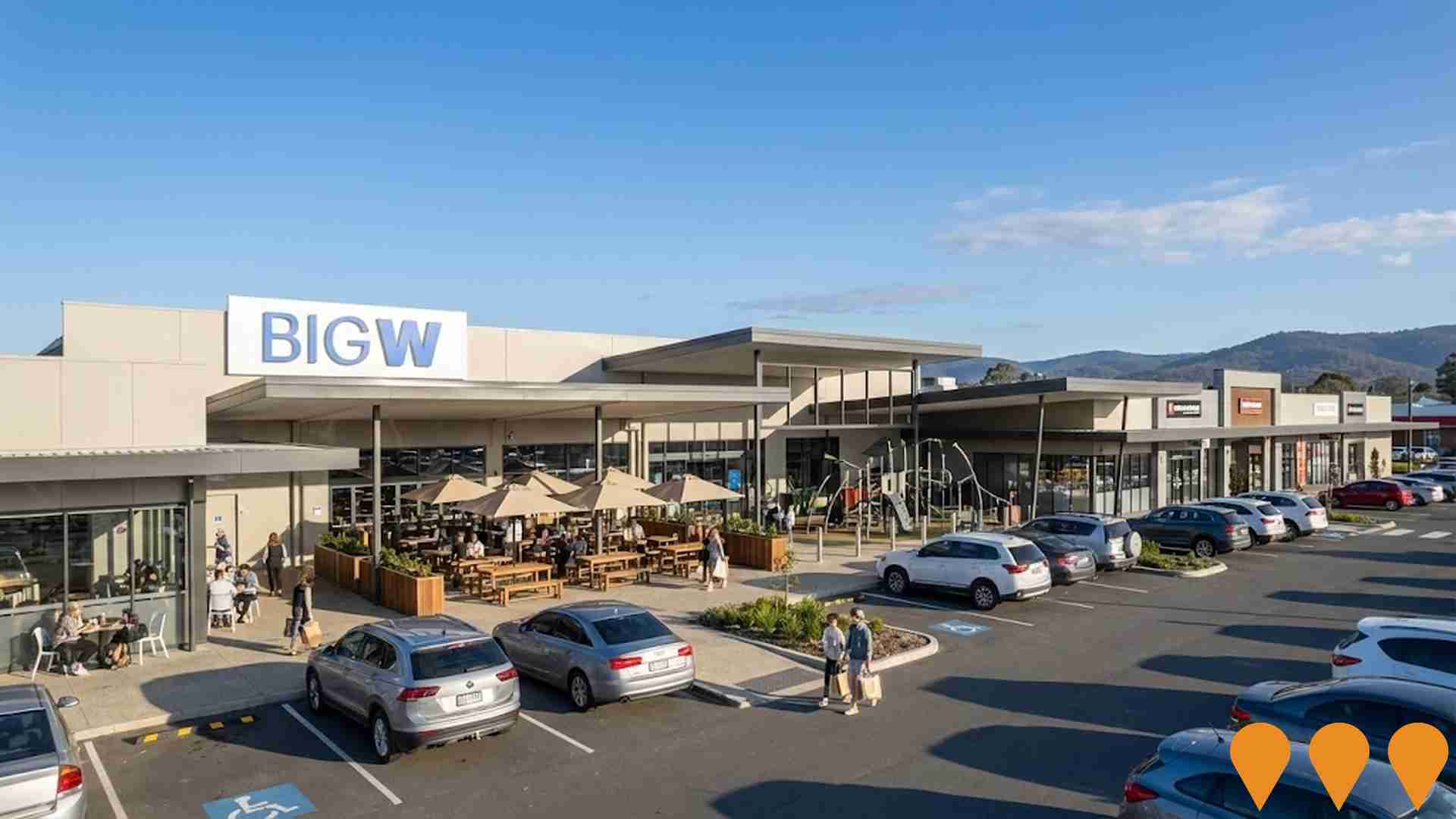
River Gum
Specialist Disability Accommodation featuring three one-bedroom villas designed for Robust and High Physical Support participants and an adjoining two-bedroom house for Improved Liveability participants. Features customized design elements including wide doorways, adjustable benches, private ensuite bathrooms with underfloor heating, assistive technology, and enhanced physical access provisions. The project represents Good Housing's first development outside Greater Sydney.

Lavington Social Housing Project
A $5 million Social Housing Accelerator Fund development delivering 10 new three-bedroom homes specifically designed for women-led families, particularly those escaping domestic and family violence. At least 10% of homes are allocated to Aboriginal women, with tenants selected from the social housing register. The development features gender-responsive design principles focused on safety, security, and family-friendly layouts.

Kerr Road Infrastructure Upgrades
Installation of essential services infrastructure and road upgrades along Kerr Road. The project includes a new sewer pipeline followed by a new water main, and road upgrades from Thurgoona Drive to the creek crossing near Brooklyn Fields. This infrastructure supports the growth of the Thurgoona-Wirlinga area, connecting with the wider Thurgoona Link Road project.

Bright Steps Academy Lavington
DA approved 136-place childcare centre with Agreement for Lease (AFL) to Bright Steps Academy. Single-level development with at-grade parking for 35 vehicles on 3,617 sqm R1 zoned site. Features 20-year lease plus options with established operator across multiple states.

Employment
AreaSearch assessment indicates Lavington faces employment challenges relative to the majority of Australian markets
Lavington's workforce is balanced across white and blue-collar jobs, with prominent essential services sectors. The unemployment rate was 6.7% in June 2025, showing an employment growth of 3.9% over the past year.
As of that date, 8,123 residents were employed, with an unemployment rate of 3.1%, higher than Rest of NSW's rate of 3.7%. Workforce participation was similar to Rest of NSW at 56.4%. Key industries for employment among residents are health care & social assistance, retail trade, and construction. Lavington specializes in manufacturing, with an employment share 1.7 times the regional level.
However, agriculture, forestry & fishing is under-represented, with only 1.3% of Lavington's workforce compared to 5.3% in Rest of NSW. Employment opportunities appear limited locally based on Census data analysis. Between June 2024 and June 2025, employment levels increased by 3.9%, while labour force grew by 4.5%, causing the unemployment rate to rise by 0.5 percentage points. In comparison, Rest of NSW recorded an employment decline of 0.1% and a labour force growth of 0.3%, with unemployment rising by 0.4 percentage points. Jobs and Skills Australia's national employment forecasts from May 2025 project national employment growth of 6.6% over five years and 13.7% over ten years, varying significantly between industry sectors. Applying these projections to Lavington's employment mix suggests local growth of approximately 6.1% over five years and 13.1% over ten years.
Frequently Asked Questions - Employment
Income
Income figures position the area below 75% of locations analysed nationally by AreaSearch
AreaSearch's latest postcode level ATO data for financial year 2022 shows that Lavington's median income is $47,725 and average income is $52,752. This is below the national average. In comparison, Rest of NSW has a median income of $49,459 and an average income of $62,998. Based on Wage Price Index growth of 12.61% since financial year 2022, current estimates for Lavington would be approximately $53,743 (median) and $59,404 (average) as of September 2025. The 2021 Census data reveals that incomes in Lavington fall between the 9th and 19th percentiles nationally for households, families, and individuals. The predominant income cohort spans 28.7% of locals (4,552 people) earning $1,500 - 2,999 per week, which is similar to the broader area at 29.9%. Housing affordability pressures are severe in Lavington, with only 83.6% of income remaining after housing costs, ranking at the 11th percentile nationally.
Frequently Asked Questions - Income
Housing
Lavington is characterized by a predominantly suburban housing profile, with a higher proportion of rental properties than the broader region
In Lavington, as per the latest Census evaluation, 77.9% of dwellings were houses, with the remaining 22.2% comprising semi-detached homes, apartments, and other types. This contrasts with Non-Metro NSW's figures of 83.2% houses and 16.8% other dwellings. Home ownership in Lavington stood at 31.2%, with mortgaged properties at 29.2% and rented ones at 39.7%. The median monthly mortgage repayment was $1,300, lower than Non-Metro NSW's average of $1,430, while the median weekly rent was $250, compared to Non-Metro NSW's $265. Nationally, Lavington's mortgage repayments were significantly lower at $1,300 against Australia's average of $1,863, and rents were substantially below the national figure of $375.
Frequently Asked Questions - Housing
Household Composition
Lavington features high concentrations of lone person households and group households, with a lower-than-average median household size
Family households account for 60.3 percent of all households, including 21.0 percent couples with children, 23.9 percent couples without children, and 14.3 percent single parent families. Non-family households constitute the remaining 39.7 percent, with lone person households at 35.9 percent and group households comprising 3.8 percent of the total. The median household size is 2.2 people, which is smaller than the Rest of NSW average of 2.4.
Frequently Asked Questions - Households
Local Schools & Education
Lavington faces educational challenges, with performance metrics placing it in the bottom quartile of areas assessed nationally
The area's university qualification rate is 13.5%, significantly lower than the NSW average of 32.2%. Bachelor degrees are most common at 9.4%, followed by postgraduate qualifications (2.7%) and graduate diplomas (1.4%). Vocational credentials are prominent, with 41.5% of residents aged 15+ holding them - advanced diplomas (9.7%) and certificates (31.8%). Educational participation is high at 28.6%, including primary education (9.8%), secondary education (7.6%), and tertiary education (2.9%).
Lavington has a network of 7 schools educating approximately 1,998 students, comprising 5 primary, 1 secondary, and 1 K-12 school. School places per 100 residents are lower than the regional average at 12.6, with some students possibly attending schools in nearby areas.
Frequently Asked Questions - Education
Schools Detail
Nearby Services & Amenities
Transport
Transport servicing is moderate compared to other areas nationally based on assessment of service frequency, route connectivity and accessibility
The analysis of public transportation in Lavington shows that there are currently 228 active transport stops operating within the area. These stops serve a mix of bus routes, totaling 50 individual routes. Together, these routes facilitate 1,424 weekly passenger trips.
The accessibility of transport in Lavington is rated as excellent, with residents on average being located just 138 meters from their nearest transport stop. Across all routes, service frequency averages at 203 trips per day, which equates to approximately 6 weekly trips per individual stop.
Frequently Asked Questions - Transport
Transport Stops Detail
Health
Health performance in Lavington is well below average with prevalence of common health conditions notable across both younger and older age cohorts
Lavington faces significant health challenges, as indicated by its health data. Both younger and older age groups exhibit high prevalence rates for common health conditions. Only approximately 47% (~7,407 people) of Lavington's total population has private health cover, which is lower than the Rest of NSW average of 50.9%.
Nationally, this figure stands at 55.3%. Mental health issues and arthritis are the most prevalent conditions in Lavington, affecting 11.4% and 9.9% of residents respectively. However, 60.4% of residents report having no medical ailments, compared to 64.2% across Rest of NSW. Lavington has a higher proportion of seniors aged 65 and over at 21.7% (3,437 people), compared to the Rest of NSW average of 20.1%. The health outcomes among seniors in Lavington broadly align with those of the general population.
Frequently Asked Questions - Health
Cultural Diversity
In terms of cultural diversity, Lavington records figures broadly comparable to the national average, as found in AreaSearch's assessment of a number of language and cultural background related metrics
Lavington's cultural diversity was found to align with the wider region's average. 86.0% of its population were citizens, 83.7% were born in Australia, and 87.5% spoke English only at home. Christianity dominated Lavington's religious landscape, with 49.7% of people identifying as such.
Notably, the 'Other' religion category comprised 2.6% of Lavington's population, compared to 1.4% across Rest of NSW. In terms of ancestry, Australian was the most represented group at 28.9%, followed by English at 28.6% and Irish at 8.5%. Some ethnic groups showed notable differences: German was overrepresented at 5.7% (vs regional average of 5.9%), Australian Aboriginal at 3.4% (vs 2.7%), and Filipino at 1.3% (vs 0.7%).
Frequently Asked Questions - Diversity
Age
Lavington's population is slightly older than the national pattern
The median age in Lavington is 40 years, which is slightly below Rest of NSW's average of 43 but above Australia's median of 38. The 25-34 age group comprises 15.2% of Lavington's population, higher than the Rest of NSW average, while the 55-64 cohort makes up 11.2%, lower than the regional average. Between the 2021 Census and now, the 25 to 34 age group has grown from 13.5% to 15.2%. Conversely, the 65 to 74 cohort has decreased from 12.1% to 11.5%. By 2041, population forecasts indicate significant demographic shifts in Lavington. The 25-34 age group is projected to increase by 880 people (36%), reaching 3,298 from the current 2,417. Meanwhile, the 55-64 and 65-74 cohorts are expected to decrease in population.

